Neukölln (locality)
Neukölln[1] (formerly Rixdorf), until 1920 an independent city, is an inner-city district[2] of Berlin in the homonymous borough (Bezirk) of Neukölln,[3] including the historic village of Alt-Rixdorf and numerous Gründerzeit apartment blocks. With 166,714 inhabitants (2018) the Ortsteil is the most densely populated of Berlin. It was originally characterized by mostly working-class inhabitants and later a relatively high percentage of immigrants, especially of Turkish and Russian descent, but since the turn of the millennium an influx of students, creatives, and western immigrants has led to gentrification.
Neukölln | |
|---|---|
District of Berlin | |
Hermannplatz | |
Location of Neukölln in Neukölln borough and Berlin 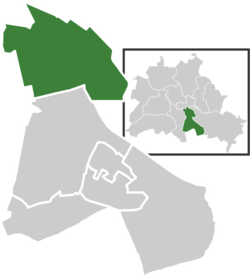 | |
 Neukölln  Neukölln | |
| Coordinates: 52°28′53″N 13°26′07″E | |
| Country | Germany |
| State | Berlin |
| City | Berlin |
| Borough | Neukölln |
| Founded | 26 June 1360 (official), ca. 1200 (inofficial) |
| Subdivisions | 9 neighborhoods or 18 regions |
| Area | |
| • Total | 11.7 km2 (4.5 sq mi) |
| Elevation | 52 m (171 ft) |
| Population (2018-06-30) | |
| • Total | 166,714 |
| • Density | 14,000/km2 (37,000/sq mi) |
| Time zone | CET/CEST (UTC+1/+2) |
| Postal codes | (nr. 0801) 12043, 12045, 12047, 12049, 12051, 12053, 12055, 12057, 12059 |
| Vehicle registration | B |
Geography
Neukölln lies on the geological border between the shallow Berliner Urstromtal glacial valley and the Tempelhofer Berge,[4] which are situated in the northernmost region of the Teltow ground moraine plateau, rising to the south of Hermannplatz, in what is mostly the typical low-lying marshy woodlands with a mainly flat topography of the North European Plain.[5]

Location
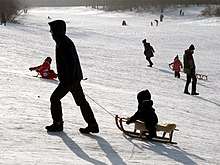
The district is situated south-east of the Berlin city center, in the north of the Neukölln borough, adjacent to the district of Kreuzberg (in the Friedrichshain-Kreuzberg borough) at the Landwehrkanal, and the streets Hasenheide and Kottbusser Damm. It also borders with the districts Alt-Treptow, Plänterwald and Baumschulenweg (all part of Treptow-Köpenick) in the east, and Tempelhof (in Tempelhof-Schöneberg) in the west, separated by the parks Volkspark Hasenheide and Tempelhofer Feld, the vast field of the former Tempelhof Airport, now a popular recreation area. In the south, the Stadtring motorway and the Neukölln Ship and Britz canals form the border with the Britz and Baumschulenweg districts.
Subdivisions
Neighborhoods
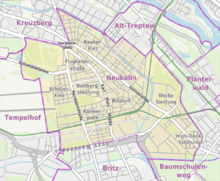
Neukölln is divided into nine official neighborhoods (Kieze or Stadtquartiere, officially called Ortslagen),[6] among them the historical sites of Neukölln's foundation south-east of the districts's geographical center, Richardplatz-Süd[7] to the north-west, and Böhmisch-Rixdorf[8] to the south-east, which together are commonly referred to as Rixdorf or Alt-Rixdorf ("Old Rixdorf"). The other official neighborhoods are (from north to south):
Other quarters
Other city quarters not officially named or recognized as neighborhoods are the Donaukiez along Donaustraße between Sonnenallee and Karl-Marx-Straße, the Weserkiez east of Wildenbruchstraße between Weigandufer and Sonnenallee, the Dammwegsiedlung south of Dammweg, as well as large living quarters north of the Neukölln Ship Canal, and south of the Berlin Hermannstraße and Berlin Neukölln stations. At the western and eastern outskirts there are recreational spaces—a large area of privately leased garden plots in the east, and the park Volkspark Hasenheide with surrounding buildings in the west—, while industrial areas have formed mostly to the south and east of the Berlin Ringbahn.
Urban planning
In urban planning, the divisions of Berlin's boroughs and districts are more precise. Here Neukölln, district 01 in borough 08, is divided into five regions, each of them further compartmentalized into a total of 18 so-called Lebensweltlich orientierte Räume (LOR) ("lifeworld-oriented regions"):[15]
- Schillerpromenade (01) in the west, comprising Hasenheide (15), Wissmannstraße (16), Schillerpromenade (17), and Silbersteinstraße (18);
- Neuköllner Mitte (02) in the center, comprising Flughafenstraße (11), Rollberg (12), Körnerpark (13), and Glasower Straße (14);
- Reuterstraße (03) in the north, comprising Reuterkiez (01), Bouchéstraße (02), and Donaustraße (03);
- Rixdorf (04) in the center to the north-east, comprising Böhmisch-Rixdorf and Richardplatz-Süd as Rixdorf (04), Hertzbergplatz (05), Treptower Straße Nord (06), and the industrial park Ederstraße (07); and
- Köllnische Heide (05) in the east, comprising Weiße Siedlung (08), Schulenburgpark (09) including the High-Deck-Siedlung, and the industrial park Köllnische Heide (10).
History
In the 12th century the region around modern-day Berlin came under German rule as part of the Margraviate of Brandenburg, founded by Albert the Bear in 1157. The region was originally situated near the borders to the Duchy of Kopanica, ruled by Jaxa of Köpenick, and the Duchy of Pomerania, which had all fought for dominance during the colonization of the Teltow and the formation of Brandenburg (Ostsiedlung). Archeological traces of earlier Slavic settlements were never found.
Early history
The place later known as Rixdorf was founded around 1200 as a stronghold by the Knights Templar from neighbouring Tempelhove, Merghenvelde and Mergendorp. The Templar functioned as a neutral institution, and when the conflicts had ended, the stronghold was abandoned and eventually converted into a Templar access yard. After Pope Clement V had dissolved the order in 1312, the estate was held by Waldemar the Great for six years, and then transferred to the Protestant Order of Saint John (Johanniterorden) in 1318, still represented today by Neukölln's coat of arms bearing the Maltese cross.
Rixdorf

When first mentioned in a charter of June 26, 1360, the angerdorf south-east of Berlin around the present-day Richardplatz was called Richarsdorp ("Richard's Village"). The original Rixdorf charter has been lost since World War II, but its contents have been preserved, and the year 1360 is regarded as the official year of Neukölln's foundation.[16] The village was mentioned again in 1375 as Richardstorpp in the Landbuch der Mark Brandenburg. At the beginning of the 15th century, Richarsdorp erected its first chapel.[17] In 1435 the Johannite Order sold their possessions to the cities of Alt-Berlin and Cölln, including Richarsdorp, which was mentioned again in 1525 as Ricksdorf. In 1543 Ricksdorf became the sole possession of Cölln. During the Thirty Years' War (1618–48) Ricksdorf was mostly depopulated, with buildings and the church destroyed by fire. After the city of Cölln merged with Berlin in 1709, the village, then already called Rixdorf, became the possession of Berlin.
Deutsch-Rixdorf and Böhmisch-Rixdorf
In 1737 King Frederick William I of Prussia allowed about 350 Moravian Protestants expelled from Bohemia to settle near the village,[18] where they built their own church and houses off the village centre along the road to Berlin, today called Richardstraße. The original village of Rixdorf was subsequently called Deutsch-Rixdorf. The new Bohemian village Böhmisch-Rixdorf was granted its own constitution in 1797.
The overall population in 1809 was 695.[19] In the course of industrialization in the 19th century, a network of new streets was laid out as part of the Hobrecht-Plan in an area that came to be known architecturally as the Wilhelmine Ring. On 28 April 1849, more than a quarter of the buildings in both Rixdorf villages were destroyed in a firestorm, and reconstruction lasted until 1853. In 1863 a Turkish cemetery was laid out north of Rixdorf, the successor of a smaller burial ground in Kreuzberg established in 1798 for the Turkish members of the Prussian Army. It contains the mortal remains of the Ottoman ambassador Giritli Ali Aziz Efendi, the exiled Grand Vizier Mehmed Talat and Bahattin Şakir.
In 1867 Deutsch-Rixdorf had a population of 5,000, and Böhmisch-Rixdorf of 1,500. When both villages were united as Rixdorf on January 1, 1874,[20] the new town had 8,000 inhabitants, growing to 15,000 the next year. On April 1, 1899, Rixdorf, then the largest town of Prussia, received the status of an independent city.
Neukölln
Rixdorf had become notorious for its taverns and amusement sites, and in 1912 the local authorities tried to get rid of this reputation by assuming the name Neukölln, derived from the Neucöllner Siedlungen ("Neucölln Estates") north of Rixdorf, which themselves referenced Neu-Cölln, a historical district south of the medieval part of Berlin and Cölln proper.[21] The renaming was eventually granted by Emperor William I on January 27, 1912. It was during this time that the architect Reinhold Kiehl was called on by the local council to upgrade the city's infrastructure. This has led to some of the area's most iconic buildings being erected, such as the Rathaus Neukölln (city hall) or the Stadtbad Neukölln (public bath).[22]
Neukölln's independence ended in 1920 when it was incorporated into Berlin as part of the Greater Berlin Act and, together with the districts Britz, Rudow and Buckow, formed the new borough of Neukölln, Berlin's 14th (and since the 2001 reform 8th) administrative district. Rixdorf continued to exist, and is today represented by two neighborhoods in the center of Neukölln, Böhmisch-Rixdorf and Richardplatz-Süd. Many of the old landmarks are still intact, and several areas and streets like the Bohemian Kirchgasse have retained their idyllic and rural character.
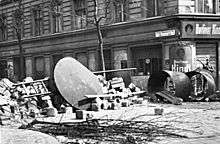
Berlin-Neukölln
In the Weimar Republic Neukölln remained a working-class district and communist stronghold. This led to increasing tensions between left-wing radicals like the KPD and the Berlin police, culminating in the Bloody May riots of 1929 (Blutmai). The Nazis viewed the district as "Red Neukölln", and tensions with the rivaling socialist and communist groups ensued as early as November 1926, when Joseph Goebbels sent over 300 men of the Sturmabteilung (SA) on a propaganda march through Neukölln, ending in clashes on the Hermannplatz. The conflict intensified until the end of the republic, leading to occasional armed engagements like the Rixdorf shootout of October 1931, when communists attacked the Richardsburg, a Sturmlokal of the SA. After the National Socialists' rise to power in 1933, the SA extended their campaigns and also targeted rallies and events by moderate parties like the SPD.[23]
From 1945 to 1990, Neukölln was part of the American sector of West Berlin. The Sonnenallee, connecting Neukölln at Hermannplatz with Baumschulenweg in former East Berlin, was the site of a border crossing of the Berlin Wall.[24] During the Cold War Neukölln retained its status as a traditional working-class area and one of Berlin's red-light districts. Many gastarbeiter, especially from Turkey and Greece, settled in Kreuzberg and Neukölln since the 1950s, later followed by Palestinian and Arabic refugees from the Lebanese Civil War. Since the 1970s and 80s, Neukölln, like the neighboring Kreuzberg, has embraced alternative forms of living and an often anti-establishment culture that is still vibrant to this day. In the 1990s late repatriates from formerly Soviet states like Ukraine and Russia resettled in Germany, many of them in Berlin, and in Neukölln specifically.
Following a decade as a typical inner-city hot spot, 21st century Neukölln has experienced an influx of students, creatives and other young professionals of mostly Western origin avoiding higher rents charged in other parts of Berlin. The trend increased after the 2008 financial and 2010 European debt crises, when many young EU citizens left their home countries for Germany in search of work, leading to rapid cultural shifts in certain neighborhoods within Neukölln, especially the neighborhoods to the north and west from Reuter- to Schillerkiez. Coupled with increasing domestic and foreign real estate investments, this has caused gentrification and a knock-on effect of rents to rise in many parts of Neukölln.[25][26] Conversely, this cosmopolitan evolution has made Neukölln into one of the world's most sought-after neighborhoods to visit and live.
The latest influx of new arrivals began with the abolishment of several Schengen restrictions, followed by immigrants after the onset of the Syrian Civil War in 2011, which intensified in 2015 during the so-called European migrant crisis, leading to an increase of residents with a migration background by 2.6 percentage points to a total of 20.6 percent in Greater Neukölln.[27]
Public transport
The district is served by three operational sections of urban rail.
- U7: Rathaus Spandau ↔ Rudow (running North West ↔ South East)
- U8: Wittenau ↔ Hermannstraße (running North ↔ South)
Part of each of the following S-Bahn routes share an East ↔ West running section of Ringbahn track through the district:
- S41[28]/S42:[29] Südkreuz → Gesundbrunnen → Südkreuz (clockwise ↔ anti clockwise circular)
- S45:[30] Südkreuz ↔ Berlin Schönefeld Flughafen (only from Monday till Friday). An extension of the S45 is projected to run beyond the current terminus at Schönefeld Airport to the under construction Berlin Brandenburg Airport.[31]
- S46:[32] Westend ↔ Königs Wusterhausen
- S47:[33] Spindlersfeld ↔ Hermannstraße
Among the numerous rail stations in the district three act as interchanges:
- Hermannplatz – U7 / U8
- Hermannstraße – U8 / S-Bahn
- Berlin-Neukölln – U7 / S-bahn
Main sights
- Rixdorf village church, consecrated in 1481, adopted by the Moravian Protestants in 1737, officially called Bethlehem Church since 1912.
- Şehitlik Mosque, on the Turkish cemetery, finished in 2005 by the Turkish-Islamic Union for Religious Affairs (DİTİB).
- Neuköllner Oper: Opera house that hosts a wide range of performances including musicals, baroque opera, operetta, or experimental music theatre. Famous for its aim to bring elitist culture to a wider audience.[34]
- Brückenbunker at Elsensteg (finished in December 2019): an exercise in urban communal resistance, realized by two young Argentinian architects, Ramiro Carro and Lucas Ibarra, who have made Berlin their chosen home. Brückenbunker was conceptualized as a metaphor against the ongoing "rent war" in the German capital by providing ungoverned space for radical inclusion, open community, and latent being.The project was co-curated by the Berlin-based intercultural consultant Johanna Roegele.
People who live or lived in Neukölln
.jpg)
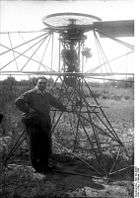
- Sebastian Blomberg (born 1972), actor
- Ursula Goetze (1916–1943), resistance fighter
- Heinz Chapel (1913–1941), politician (KPD) and resistance fighter
- Kurt Krömer (born 1974), presenter, actor and entertainer
- Will Meisel (1897–1967), composer and publisher
- Werner Seelenbinder (1904–1944), wrestler, politician (KPD) and resistance fighter
- Katharina Szelinski-Singer (1918–2010), sculptor
- Emil Wutzky (1871–1963), trade unionist and local politician (SPD)
- Engelbert Zaschka (1895–1955), inventor and helicopter pioneer
- Margarete Stokowski (born 1986), feminist writer and essayist
Photo gallery
 Country Court
Country Court City hall
City hall_Buddy_B%C3%A4r.jpg) Buddy Bear Neukölln in front of the City hall
Buddy Bear Neukölln in front of the City hall Landwehrkanal
Landwehrkanal Border crossing at Sonnenallee, 1964
Border crossing at Sonnenallee, 1964 Stadtbad Neukölln
Stadtbad Neukölln
International relations
- Berlin Neukölln is a pilot city of the Council of Europe and the European Commission Intercultural Cities programme.[35]
Notes and references
- Translated "New Kölln", and etymologically "New Colony" from lat. colonia; cf. also Roman Cologne. Not to be confused with Berlin's historical district of Neu-Cölln.
- Administratively the locality of Neukölln is a district (Ortsteil) of the Neukölln borough (known as Verwaltungsbezirk, in Berlin simply called Bezirk). Different from the borough, the district of Neukölln has no mayor and representatives of its own.
- To distinguish the district from the borough, the former is also called Berlin-Neukölln or Nord-Neukölln. Over the years there have been several petitions to reestablish the historical name Rixdorf; cf. Kai Ritzmann, "Aus (Nord-)Neukölln soll wieder Rixdorf werden", 1 July 2019, B.Z..
- See also the Kreuzberg, which is Berlin's most prominent glacial hill in the Tempelhofer Berge range.
- See also Geography of Berlin.
- Cf. "Neukölln".
- Also known as Richardkiez; the original Richarsdorp/Rixdorf, later Deutsch-Rixdorf.
- Also known as Böhmisches Dorf.
- Also known as Reuterquartier; together with the adjacent parts of Kreuzberg sometimes jokingly referred to as Kreuzkölln (cf. Johannes Schneider, "Sagt endlich Kreuzkölln!", 12 April 2016, Der Tagesspiegel), a portmanteau of "Kreuzberg" and "Neukölln", the former's SO 36 and Kreuzberg 61 quarters bordering to the north and west respectively. The short hand X-Kölln is also in use.
- Often referred to as Flughafenkiez, seldomly as Flughafenstraßenkiez.
- Also called Schillerkiez.
- Also called Rollbergkiez or Rollbergsiedlung.
- Sometimes referred to as Körnerkiez.
- Also called Sängerviertel ("Singers' Quarter") due to several street names.
- Amt für Statistik Berlin-Brandenburg, "Adressverzeichnisfür die lebensweltlich orientierten Räume", Berlin 2018; official neighborhoods emphasized.
- Cf. the 650-years anniversary edition "Rixdorf – 650 – Neukölln" of Mitteilungen des Vereins für die Geschichte Berlins (Vol. 3, 2010).
- Before 1400 the village had to pay tributes to the priest at Tempelhof, which rules out a church in Rixdorf during these early times.
- Bohemia became primarily catholic again after the Battle of White Mountain, which led to persecutions of the Protestant minority, many of whom subsequently left the country.
- Schneider R. 1993. Neukölln – Ein Bezirk von Berlin. Berlin.
- By royal decree of July 11, 1873.
- The historical Neu-Cölln (sometimes Neu-Cöln or neu Cölln) was at first also called Neu-Cölln am Wasser ("New Cölln by the water"). It was built in 1662 as the southern extension of the city of Cölln, and remained a small district of Berlin until the Greater Berlin Act of 1920, when it was dissolved in the new Mitte district of the homonymous borough. Today the area is part of the Luisenstadt neighborhood (named after the historical Luisenstadt), and it is almost never called by its historical name, but places like the Köllnischer Park, originally a military bastion in Neu-Cölln, still point to the origin of the toponym Neukölln.
- Krawczynski, Wolfgang. Architekt Reinhold Kiehl, Stadtbaurat in Rixdorf bei Berlin: Biographie, Werkverzeichnis, Beiträge : Jubiläumsbeitrag zur 750-Jahr-Feier Berlin. 1987
- Bernhard Sauer, "Goebbels 'Rabauken': Zur Geschichte der SA in Berlin-Brandenburg", in: Landesarchiv Berlin, Berlin in Geschichte und Gegenwart. Jahrbuch des Landesarchivs Berlin 2006, Berlin 2006, 107-64 (114 with n. 77, 132, 141).
- Featured prominently in the 1999 comedy film Sonnenallee.
- Moises Mendoza, "Foreigners Feel Accused in Berlin Gentrification Row", 11 March 2011, Der Spiegel.
- As of 2017, in Berlin-Neukölln "the [gentrification] boom [was] in full swing or, in some places, complete (no more big hikes in rent here)"; cf. Meier J, RealXData. 2019. "Zeitraum Mietentwicklungen 2013–2017". In: Bruns H. 2019. "At A Glance: Which Berlin Districts are Going to Get More Expensive". B.Z. – Berliner Zeitung. 19 November 2019.
- Against a Berlin-wide increase of 1.9% between 2010 and 2018 to 14.1%; cf. Klaus Hurrelmann in: Hildeburg Bruns, "Berlin wird immer bunter und internationaler", 11 July 2019, B.Z..
- S41 "Bahnhofs- und Linieninformationssystem" s-bahn-berlin.de accessed 19 March 2018
- S42 "Bahnhofs- und Linieninformationssystem" s-bahn-berlin.de accessed 19 March 2018
- S45 "Bahnhofs- und Linieninformationssystem" s-bahn-berlin.de accessed 91 march 2018
- "2020 vision for Berlin's long-overdue Brandenburg Airport" Travel weekly, 9 January 2018
- S45 "Bahnhofs- und Linieninformationssystem" s-bahn-berlin.de accessed 19 March 2018
- S47 "Bahnhofs- und Linieninformationssystem" s-bahn-berlin.de accessed 19 March 2018
- Berlin Guide – Neukölln City Getaway Guide – Berlin
- Council of Europe (2010). "Projekt Intercultural Cities – Berlin.de". berlin.de. Archived from the original on 30 May 2008. Retrieved 22 May 2011.